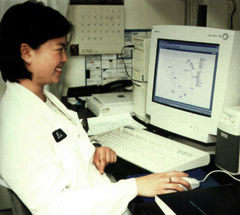
As a Research Technician in one of Cangene's development laboratories,
Esther Lo clones, analyzes, and experiments with DNA to produce
purer concentrations of some proteins or larger quantities of others.
She hopes her experiments will one day lead to a new protein-based therapeutic
drug. |
 |
 |
 |
Esther works in research lab #6 at one of Cangene’s smaller facilities,
a brown brick single-story building in Mississauga, a suburb of
Toronto. No manufacturing is done at her location.
Although six other researchers share her lab, Esther currently works
alone studying a particular protein. Esther spends most of her time
at a black lab bench in the centre of the room. Drawers on each
side and open metal shelves above hold sterile plastic test tubes,
clear plastic cone-shaped containers and other supplies. It’s here
that Esther mixes and transfers a variety of powders, liquids and
solids.
Her work requires her to perform a series of extremely precise pre-experimental
and experimental steps. Timetables and planning are everything in
Esther’s field. Before beginning her current experiments, for example,
she creates a ‘seed bank’ of culture samples from commercial bacteria
powder. She revives the bacteria with liquid nutrients that encourage
it to grow.
After waiting for a specified time, usually between one and four
days, Esther transfers the grown bacteria into several different
test tubes. To turn the bacteria into culture, she adds a liquid
substance that turns the liquid cloudy. She then stores the culture
tubes at a temperature of minus 80 degrees Celsius, which gives
them an almost unlimited lifespan. These culture tubes give Esther
a backup supply of DNA. When she wants to conduct an experiment,
she thaws one of the tubes, adds nutrients to grow a large supply,
and spins it in a centrifuge to separate a solid pellet of cell
material. Then she adds a liquid chemical, and spins the mixture
again to separate the DNA from cell debris. Afterward she pours
off a clear liquid that is almost pure DNA.
That’s when she moves away from the lab bench to her computer, to
determine which sequence of the DNA interests her. She might consult
research papers, read scientific journals, or speak with other genetic
researchers. Once she’s reached a decision, she mass-produces the
required DNA sequence, then removes or adds DNA fragments until
she’s satisfied. After that she puts the DNA back into live bacteria,
to produce large amounts or purer versions of protein. |
 |
| |
|
|


